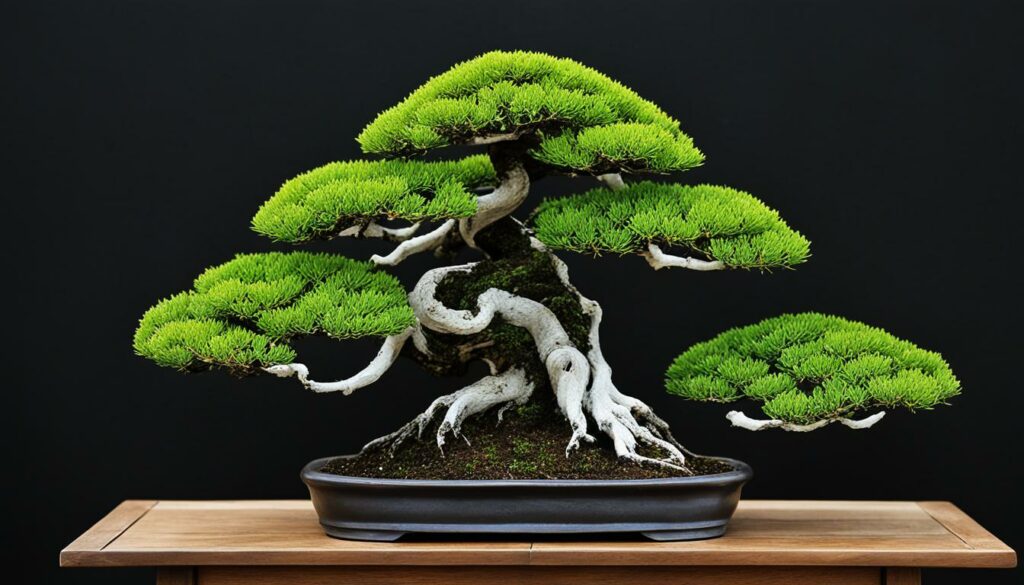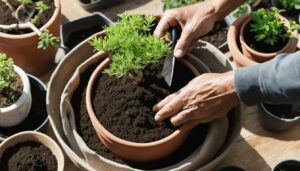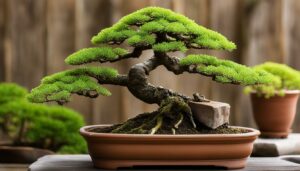Welcome to the world of bonsai cultivation using nursery stock! Bonsai is an ancient Japanese art form that involves growing and training trees into miniature living sculptures. With nursery stock, you can select the best starter trees that show bonsai potential and learn how to nurture them into stunning creations that capture the art and beauty of bonsai. In this guide, we’ll explore the history and principles of bonsai, the tools and techniques used in bonsai cultivation, and how to troubleshoot common bonsai issues.
Key Takeaways:
- Bonsai cultivation involves selecting the best starter trees that exhibit bonsai potential.
- Nurturing nursery stock into living sculptures requires fundamental care practices such as watering, fertilization, and light and temperature considerations.
- Tools such as pruning shears, concave cutters, and wiring techniques are essential in shaping and refining nursery stock into stunning bonsai specimens.
- Assessing bonsai potential in nursery stock trees involves envisioning the future form and artistic expression of the tree through careful cultivation and shaping techniques.
- Troubleshooting common bonsai issues such as pests and diseases is crucial in maintaining the health of your bonsai creations.
What is Bonsai?
Before delving into the art of nursery stock bonsai, it’s important to understand the essence of this ancient art form. Bonsai is a Japanese word that literally means “planted in a container.” It involves cultivating small trees and plants in containers that mimic their natural environment, while simultaneously shaping them in aesthetically pleasing ways.
For centuries, bonsai has been considered an art form that requires patience, dedication, and a deep appreciation for nature. It embodies concepts such as minimalism, asymmetry, and harmony with the surrounding environment.
Dedicated bonsai nurseries provide the raw materials for your own bonsai creations. These nurseries specialize in cultivating trees and plants that exhibit bonsai potential, carefully selecting and nurturing them to develop the desired characteristics of a bonsai specimen. It’s these nurseries that offer an extraordinary range of starter trees, such as junipers, maples, and pines, which can be grown into beautiful bonsai specimens over time.
The History of Bonsai
The history of bonsai dates back centuries, with its roots in ancient China and Japan. Traditionally, it was a hobby enjoyed by the aristocracy and the Samurai class. Eventually, it spread throughout the world as a beloved art form and hobby.
“The art of Bonsai, which recreates the natural beauty of trees in pots, dates back to the 6th century A.D…” – The Washington Post
The Principles of Bonsai
Bonsai cultivation involves shaping a tree or plant to mimic its mature, natural form, while keeping it small and compact enough to fit in a pot. This requires careful pruning, wiring, and shaping techniques that take into account the growth patterns of each specific species. The goal is to create an aesthetically pleasing specimen that embodies balance, simplicity, and harmony with its surroundings.
Selecting Nursery Stock for Bonsai
When it comes to selecting the right nursery stock for your bonsai journey, it’s essential to consider several key factors to ensure the best possible start. The raw material for your bonsai creations should have the potential to become living sculptures, so every detail must be taken into account.
Starter Trees
The most critical consideration is the tree’s selection as a bonsai starter. While any tree can technically be turned into a bonsai, some species have a better chance of thriving with the right care and techniques. Look for trees with small leaves, interesting bark, and branching patterns that are conducive to bonsai creation.
Raw Material
Additionally, the raw material should be in good health, free from diseases and pests that could compromise the tree’s growth and development. Inspect the tree for any signs of damage or rot, as these may be symptomatic of underlying issues that could render the tree unsuitable as a bonsai starter.
| Factors to Consider | What to Look For |
|---|---|
| Trunk Thickness | Choose a trunk thickness that is proportional to the height and branching structure of the selected species, as this will affect the overall aesthetic appeal of your bonsai creation. |
| Branch Structure | Study the tree’s branching structure to determine if it conforms to basic bonsai principles, such as the Rule of Thirds or the Golden Ratio. |
| Overall Health | Check for signs of good health, such as vibrant foliage, healthy root systems, and a strong, sturdy trunk. |
By studying these factors when selecting nursery stock for your bonsai creations, you can increase the chances of success in your cultivation journey and develop exquisite living sculptures that stand the test of time.
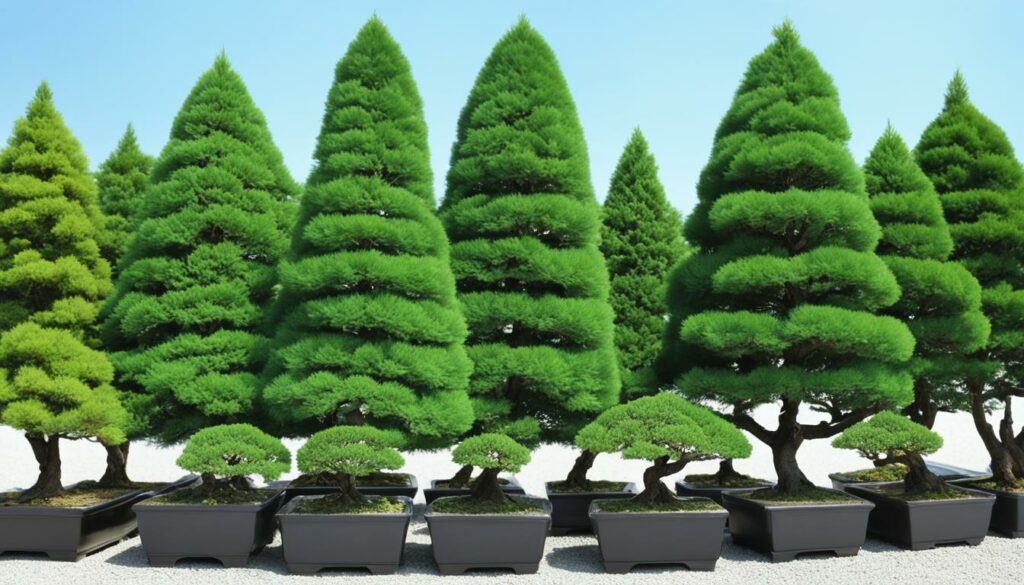
Evaluating Bonsai Potential
Assessing the bonsai potential of a nursery stock tree requires careful observation and foresight. With patience and practice, you can envision the future form and artistic expression that can be achieved with careful cultivation and shaping techniques.
Begin by examining the trunk thickness and movement. Look for a thick trunk at the base that tapers off towards the apex. This gradual narrowing is vital for creating the illusion of age and balance in the final bonsai composition.
The branch structure is also critical to consider when evaluating bonsai potential. Look for branches that grow in a naturally sweeping, horizontal pattern, with plenty of space between each branch for airflow and light penetration. Be sure to select a tree with branches that come off the trunk at alternating intervals for a more balanced and aesthetically pleasing final form.
Another essential factor to consider is the overall health of the tree. Look for trees with no or few noticeable scars, wounds, or fungus, as these can significantly affect the potential for the tree to thrive as a bonsai specimen. Ideally, the tree’s roots should also be well-established and firmly anchored in the pot or container.
When selecting a tree, it’s important to envision the future bonsai composition and the artistic expression you hope to achieve. Consider the tree’s natural characteristics, such as bark texture and leaf shape, and how you can accentuate these features to create a stunning and unique bonsai specimen.
Tip: It’s crucial to select a tree that speaks to you and inspires your creative vision. Trust your instincts and select a raw material that sparks joy and artistic expression.
Tools for Bonsai Cultivation
When it comes to bonsai cultivation, having the right tools is essential. The following are some of the essential tools needed for shaping and refining your starter trees into stunning bonsai specimens:
| Tool | Description |
|---|---|
| Pruning shears | Used for cutting small branches and twigs |
| Concave cutters | Used for making clean cuts to branches |
| Wire cutters | Used for cutting bonsai wire |
| Bonsai wire | Used for shaping branches and trunk of starter trees |
| Bud scissors | Used for cutting unwanted buds, leaves, and flowers |
| Root rake | Used for untangling roots during repotting |
These tools are readily available at local nurseries and online shops that offer bonsai supplies. Investing in high-quality tools can make the bonsai cultivation process easier, more efficient, and more enjoyable.
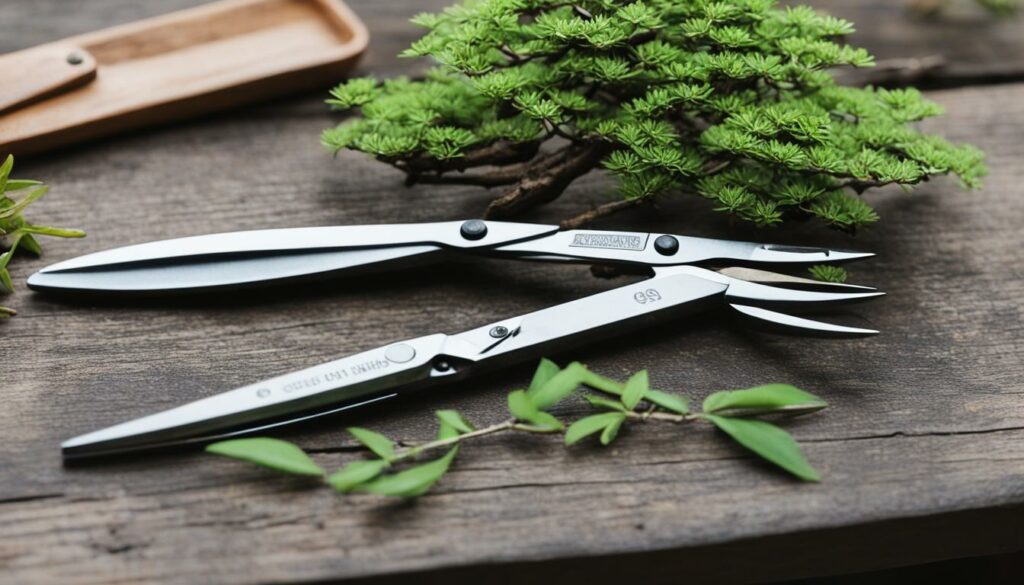
Bonsai Care Basics
Proper care is essential for the successful cultivation of your nursery stock into healthy bonsai specimens. To ensure optimal growth and development, here are some fundamental care practices to keep in mind:
- Watering: Bonsai require regular watering to maintain soil moisture. However, overwatering can lead to root rot and other issues. As a general rule, water your bonsai when the soil becomes slightly dry to the touch. The exact frequency will depend on factors such as humidity and temperature.
- Fertilization: Bonsai growth demands regular fertilization, which provides necessary nutrients for healthy development. Use a balanced, slow-release fertilizer, applying it during the growing season according to the manufacturer’s recommendations.
- Light: Light is crucial for the photosynthesis process that fuels bonsai growth. Most bonsai species require plenty of direct or indirect sunlight. Be sure to position your bonsai in a suitable location based on its species and growing requirements.
- Temperature: Similar to light, temperature plays a crucial role in bonsai health. Most bonsai species prefer moderate temperatures, around 60-75°F for optimal growth.
By following these basic care practices, you can create the optimal environment for your nursery stock to grow into thriving bonsai creations.
Wiring and Shaping Techniques
Wiring and shaping are some of the most crucial steps in bonsai cultivation, helping guide nursery stock into stunning creations. Wiring allows you to control the direction of branches and help them conform to your vision, while shaping helps refine the overall form and structure of the tree. When you first acquire your raw material, carefully assess the branches and determine which ones you want to keep and which ones need to go. Then, use wire to gently guide them into the desired direction. Remember to wrap the wire tightly but not too tightly which can damage the bark and result in injury to the tree. Beginning near the base, coil the wire around the branch, slowly spiraling the wire upward. Once you reach the end of the branch, wrap the remaining length of wire in the opposite direction, crossing back over your previous turns, which will eventually allow you to release the wire.
In shaping, you may use different techniques, like trimming, pinching, or pruning to create a balance and harmony in the tree. Most trees undergo a repetitive process of wiring and pruning, every few months or years. The best way to shape your tree is by removing branches that do not fit in your envisioned final form, leaving those that will enhance the overall shape. To learn more about wiring and shaping techniques, visit your local bonsai nursery or join a bonsai club to discuss experiences, techniques and ideas.
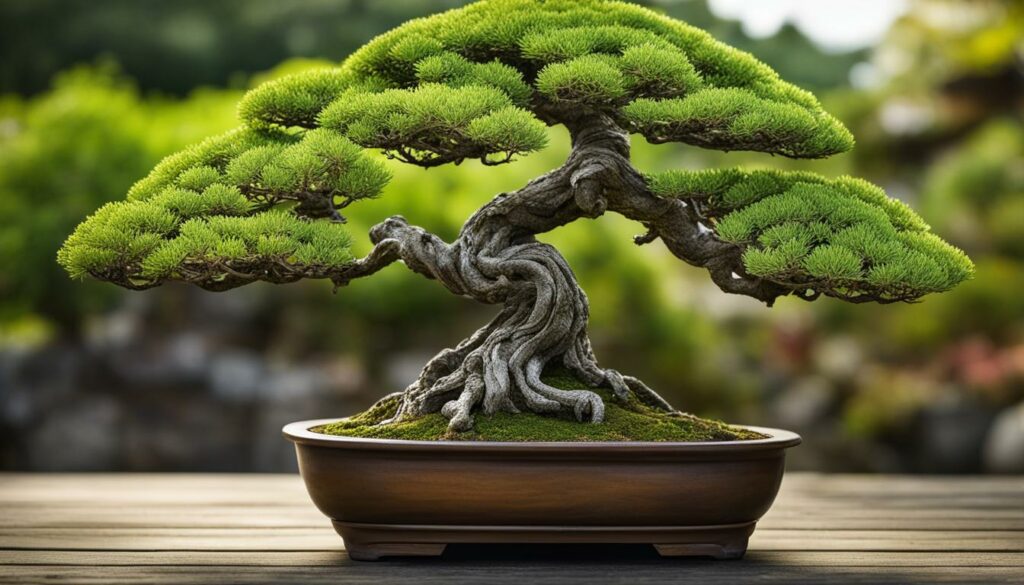
Pruning and Pinching
Proper pruning and pinching techniques are essential to maintain the aesthetic balance and promote healthy growth in your bonsai specimens. As your starter trees grow, it’s important to strategically remove certain branches and foliage to shape your bonsai into the desired form.
Pruning involves the removal of larger branches, while pinching is the removal of smaller growth. When pruning, use sharp tools and cut at a 45-degree angle to avoid damage to the bark and encourage faster healing. Pinching can be done with your fingers or small shears and is typically used to remove small twigs and buds.
Regular pruning and pinching encourage back-budding, which can help create a fuller canopy for your bonsai. As always, be cautious not to over-prune, as this can weaken the tree. Remember to take your time with this process and gradually shape your bonsai over time.
Guidelines for Pruning:
| When to prune | What to prune |
|---|---|
| Spring and late summer | Unwanted branches |
| After new growth hardens off | Branches that interfere with the overall design or aesthetic balance |
Guidelines for Pinching:
- Use your fingers or small shears to pinch back small twigs and buds.
- Start pinching after new growth has emerged.
- Pinch the tip of the branch to promote back-budding.
Repotting and Root Pruning
Repotting and root pruning are essential steps in bonsai cultivation that promote healthy growth and optimize the root system of your nursery stock trees. It is recommended to perform these actions every 2-3 years, depending on the species and growth rate.
The optimal time for repotting bonsai cultivation depends on the tree species, but typically occurs during early spring before the buds begin to open. Before repotting, prepare a suitable container based on the size of the tree and its roots. Using a sharp cutting tool, prune the roots to stimulate new growth and reduce the size, ensuring not to remove more than one-third.
Once the roots have been pruned, carefully remove the tree from its old container, remove any soil, and inspect the roots for any signs of decay, damage, or disease. Trim any affected roots with clean cutting tools.
Replant the tree in the new container, packing the soil firmly around the roots, taking care not to damage or disturb them. Water thoroughly and place your newly repotted tree in a shaded area for a few weeks to recover.
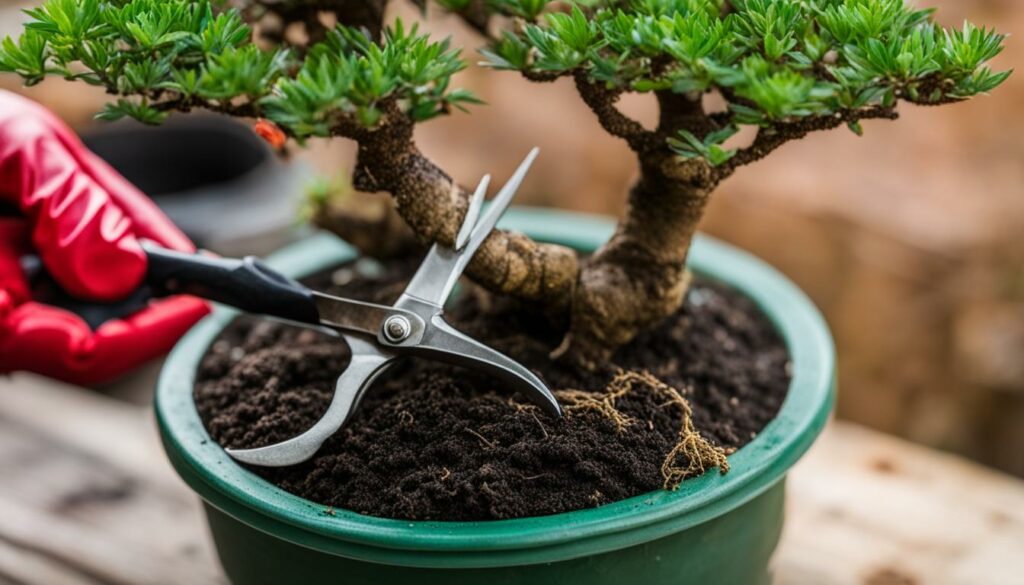
Bonsai Display and Presentation
To showcase the natural beauty of your nursery stock bonsai creations, it’s important to approach display and presentation with an artistic eye. Here are some tips on how to present your bonsai:
- Choose the right container: The container you choose to display your bonsai in should complement the aesthetic of the tree itself. Consider the color, texture, and style of the pot to ensure it enhances the natural beauty of the bonsai.
- Positioning: Place your bonsai at the right height and angle so that its best features are highlighted. Consider placing your bonsai on a stand or table to elevate it and draw attention to it.
- Showcase the landscaping: Mimic the bonsai’s natural environment with creative landscaping around it, such as adding rocks, moss, or other plants. This will enhance the visual impact of the entire display.
- Lighting: Lighting can make a huge difference in the way your bonsai is perceived. Experiment with different lighting angles and intensities to find the perfect balance that showcases your tree in the best light.
- Rotate: Regularly rotating your bonsai will help ensure that all parts of the tree are evenly exposed to sunlight and receive optimal growth.
Bonsai Presentation Tips
| Tip | Description |
|---|---|
| Find a Balance | A balance between empty space and green space will help your bonsai stand out. Leave some empty space between the pot and other elements of the display. |
| Use a Neutral Background | Using a neutral background behind your bonsai will help it stand out and not compete visually with what is around it. |
| Create a Cohesive Theme | Using complementary elements when displaying your bonsai, such as rocks, sand, and other natural items can set a cohesive theme to the presentation. |
By following these display and presentation tips, you can create a visually appealing and aesthetically pleasing display that showcases the natural beauty of your nursery stock bonsai creations.
Troubleshooting Common Bonsai Issues
Despite your best efforts, your bonsai may encounter a variety of issues during cultivation. Identifying and addressing these issues early on can help ensure your nursery stock bonsai remains healthy and thriving. Here are some common issues and ways to troubleshoot them:
Disease
One of the most common issues with bonsai is disease. Some diseases such as black spot and root rot can quickly spread and cause irreparable damage to your bonsai. To keep your bonsai healthy, ensure proper watering techniques to avoid excessive moisture. If you spot signs of disease such as yellow or brown leaves, immediately remove affected branches or leaves. Use a fungicide if necessary and repot your bonsai in fresh soil.
Pests
Another common issue with bonsai is pest infestations. Aphids, spider mites, and mealybugs are all common pests that can damage bonsai foliage and weaken the overall health of your plant. To treat pest issues, use insecticidal soap or horticultural oil. You can also use a strong stream of water to dislodge pests from your bonsai.
Environmental Stress
Bonsai are sensitive and require special care to thrive in certain conditions. High temperatures, low humidity, and lack of sunlight can cause environmental stress which can lead to stunted growth and poor overall health. Monitor your bonsai’s environment and use shading or supplemental lighting if necessary. Water your bonsai frequently and adjust watering frequency according to the temperature and humidity levels.
“It is important to address bonsai issues as soon as they arise to avoid further damage or loss of your nursery stock.”
Advanced Bonsai Techniques
Now that you have gained confidence in cultivating your starter trees, it’s time to explore advanced bonsai techniques. These methods used by experienced bonsai enthusiasts can transform the humble raw material into exquisite artistic creations.
Grafting
Grafting is a technique used to combine the strengths of two or more trees into one. It involves taking a cutting from one tree, called the scion, and attaching it to another tree or rootstock, called the stock. This technique is often used to cultivate new varieties of trees that exhibit desirable characteristics.
Layering
Layering is a technique used to create a new tree from a branch of an existing one. This can be done by making a small cut in the branch and securing it to the soil until new roots grow. This technique allows for the creation of new trees with unique characteristics, while still retaining the shape and structure of the parent tree.
Air Layering
Air layering is a variation of the layering technique. Instead of attaching the branch to soil, the branch is wrapped in a moist medium like sphagnum moss and sealed in plastic to encourage roots to grow. This technique is useful for when the branch is too high to reach or when the parent tree is too large to transplant.
Table of Advanced Bonsai Techniques
| Technique | Description |
|---|---|
| Grafting | Combines the strength of two or more trees into one. |
| Layering | Creates a new tree from a branch of an existing one. |
| Air Layering | A variation of layering that encourages roots to grow in a moist medium wrapped around a branch. |
With these advanced bonsai techniques, you can take your cultivation skills to the next level and create stunning living masterpieces. Remember to exercise patience and caution when attempting these methods, as they require careful attention to detail and precision.
Appreciating the Art of Bonsai
As you embark on your own bonsai journey, it’s important to appreciate this ancient art form for its beauty and symbolism. While bonsai cultivation may seem like a solitary activity, it is rooted in a rich tradition of communal exchanges, where enthusiasts gather to admire and exchange tips on how to craft perfect shapes from starter trees from bonsai nurseries.
The beauty of bonsai trees lies in their intricate details and symbolism. Bonsai specimens are not just miniature versions of full-sized trees, but rather a representation of the beauty and harmony found in the natural world. Bonsai artists put great care and attention to detail in creating trees that are striking in their simplicity, drawing the viewer’s eye to their grace and elegance.
One of the reasons that the bonsai tradition has endured for centuries is because creating these works of art takes time, patience, and a deep understanding of the natural world. Bonsai artists must balance aesthetics with the needs of the living tree, carefully pruning and shaping starter trees to encourage healthy growth and produce striking results.
As you continue to hone your skills in bonsai cultivation, take the time to appreciate the beauty and precision involved in creating these living works of art. By doing so, you’ll gain a deeper appreciation for the natural world and find a new way to connect with like-minded enthusiasts.
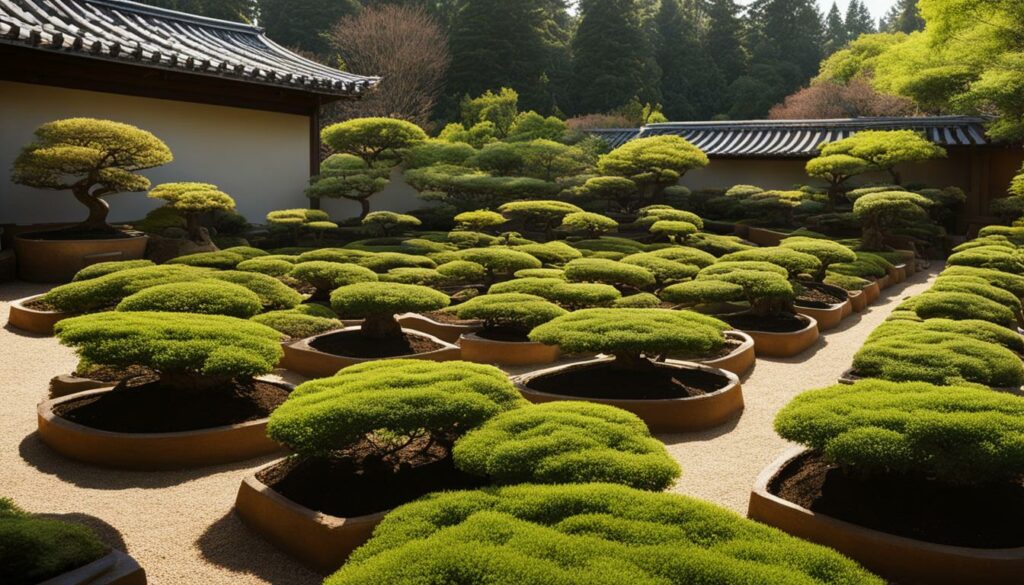
Conclusion
Congratulations! You have completed this comprehensive guide to bonsai cultivation using nursery stock. By now, you should have a deeper understanding of the principles and techniques that go into creating stunning bonsai specimens from raw material.
Remember to carefully select your starter trees and assess their potential for bonsai cultivation. Equip yourself with the necessary tools and techniques to prune, shape, and care for your bonsai creations.
With practice and patience, you can transform humble nursery stock trees into living sculptures that captivate and inspire. So go ahead, embark on your own bonsai adventure and discover the beauty of this ancient art form.
FAQ
What is bonsai?
Bonsai is an ancient art form that involves cultivating miniature trees in containers. It originated in China and Japan and focuses on creating a scaled-down representation of nature.
What is nursery stock bonsai?
Nursery stock bonsai refers to the practice of using trees from specialized bonsai nurseries as raw material for creating bonsai. These nurseries cultivate and groom trees specifically for bonsai potential.
How do I select nursery stock for bonsai?
When selecting nursery stock for bonsai, consider factors such as trunk thickness, branch structure, overall health, and the desired aesthetic style. Look for trees that have potential for shaping and refinement as bonsai specimens.
How do I evaluate the bonsai potential of nursery stock trees?
Assessing bonsai potential involves envisioning the future form and artistic expression that can be achieved with a particular tree. Look for characteristics such as desirable trunk movement, taper, and branch placement that align with your vision for the bonsai.
What tools do I need for bonsai cultivation?
Essential tools for bonsai cultivation include but are not limited to pruning shears, concave cutters, wire cutters, bonsai wire, and branch benders. These tools are used to shape and refine the nursery stock into desired bonsai aesthetics.
What are the basic care practices for bonsai cultivation?
Basic care practices for bonsai cultivation include watering, fertilization, light and temperature considerations, as well as pest and disease management. Consistency in care routines is key to ensuring the health and vitality of your nursery stock bonsai.
How do I wire and shape bonsai?
Wiring and shaping bonsai involves wrapping the branches with bonsai wire and gently bending them into desired positions. This process allows you to guide the growth and create the artistic form and structure that defines a bonsai.
Why is pruning important in bonsai cultivation?
Pruning is crucial in bonsai cultivation as it helps to maintain the balance and aesthetic appeal of the tree. By strategically removing branches and foliage, you can enhance the overall design, promote healthy growth, and create a harmonious bonsai specimen.
When should I repot and root prune my bonsai?
Repotting and root pruning should be done when the tree’s root system has outgrown the current container. This is typically done every 1-3 years, depending on the tree’s growth rate and vigor. Repotting helps maintain a healthy root system and encourages further development.
How do I display my bonsai?
Bonsai display involves selecting appropriate containers, displaying your bonsai on stands, and arranging accent elements such as rocks or figurines. The goal is to showcase the natural beauty of your nursery stock bonsai in a visually appealing and harmonious manner.
What are some common bonsai issues and how do I address them?
Common bonsai issues include pests, diseases, and environmental stressors. Regularly inspect your bonsai for signs of problems, and take appropriate measures such as applying pesticides, pruning affected areas, or adjusting environmental conditions to maintain the health of your nursery stock bonsai.
What are some advanced bonsai techniques?
Advanced bonsai techniques include grafting, layering, and air-layering, which allow for precise control and manipulation of the tree’s growth. These techniques are used by experienced bonsai enthusiasts to transform nursery stock trees into exquisite artistic creations.
How can I appreciate the art of bonsai?
To appreciate the art of bonsai, take the time to study the craftsmanship, attention to detail, and symbolism behind each bonsai specimen. Learn about the cultural and historical significance of bonsai and observe the beauty that can be achieved through meticulous cultivation of nursery stock trees.
